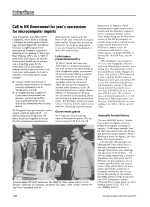Recently purchased an LSI computers LTD. M-four and I was wondering if any had information on these machines or the company itself. I've found various info on previous and later machines, unfortunately nothing for the M-Four. I assume I will need to find an original system disk for the M-Four for it to boot.
TIA
Hi Broosky4,
You’ve probably already found that LSI Computers Ltd were based in Copse Road, St. Johns, Woking, Surrey. Their manufacturing arm, CPU Computers, produced their machines – the LSI M1, M2, M3, M4 and then Octopus (code name M5).
The M4 is a dual CPU machine. The 16 bit 8088 being the primary processor with an 8 bit Z80 under its control. It came with either 128K or 256k RAM and supported two floppy drives (single or double sided 8” or 5.25” floppy drives) or a single floppy drive and a MFM hard drive (usually a Rodime drive of 5, 10, 15 or 20MB capacity controlled by a XEBEC controller). Its O/S was typically CP/M-86/80 (a version of CP/M-86 that would automatically switch in the Z80 when running older 8 bit CP/M programs) or MS-DOS.
The M4 was also rebranded as the CAL-PC for Computer Ancillaries Ltd. The difference being it was in a PC style case with PC style keyboard and external monitor. The CAL-PC motherboard was almost identical to the M4s, the differences being in how it connected to the keyboard and external monitor. The CAL-PC supported two 5.25” floppy drives or a single floppy drive and a MFM hard drive. I’ve used CP/M-86/80, Concurrent CP/M-86/80 version 2.0 and MS-DOS versions 1.25 and 2.11 on the CAL-PC. The M4 and CAL-PC utilities would run on either machine as they first checked the machines signature in the PROM.
There was a review of the LSI-M4 in the April 1983 edition of Personal Computer World, page 166. You can download a PDF copy (unfortunately not OCRed) from the Internet Archive Wayback Machine -
https://archive.org/details/PersonalComputerWorld1983-04.
I owned a couple of M4s and several CAL-PCs in the 90s. Sadly they’re long since gone. Some of the CAL-PC firmware documentation and CP/M-86 CBIOS source code I had at the time was sent to Tim Olmstead at the Unofficial CP/M Web Site – now hosted by Gaby Chaudry at
http://www.cpm.z80.de/source.html. The following may be of interest:
CALBIOS.ZIP – source code to generate CP/M-86 for the CAL-PC or M4
CALDOC.ZIP – the firmware PROM documentation for the CAL-PC and M4.
CALUTILS.ZIP – a few utilities I wrote to allow the CAL-PC to read other disk formats and to load CP/M-86 from within MS-DOS.
Several years ago (2016 to be precise) I sent some LSI documentation and software to BitSavers.org (look under folder LsiComputers). This was primarily for the LSI-M3 (as I was restoring an M3 at the time - see
https://goo.gl/photos/tMza3ootuxB6FYF38 ), the CAL-PC and the LSI-Octopus (I also own an Octopus, but it has been in storage since we moved house a couple of years ago).
Unfortunately for you, I haven’t got an LSI-M4 boot disk. However, I do have a copy of the CP/M-86/80 CPM.SYS file for the M4. Just need to work out how to create a suitable boot disk, i.e. the correct format for your machine (8” or 5.25” and single or double sided) and then create a loader track to load the CPM.SYS file. I’m guessing your machine would have DSDD 8” drives. If that’s the case I could create the correct format (as it’s the same as the M3), then need to create a loader track and add the CPM.SYS file.
And if you hadn’t already guessed, I used to work at LSI Computers - I was at the West Midlands franchise near Birmingham. I was a software developer, back then we were called computer programmers, so worked on the source code for the operating system, Sensible Solution database and a modular accounting package called AXIS MAP.
Anyway, that’s enough from me for now. How about uploading some pics, inside and out of your M4. Last, but not least, if you haven’t already done so, I’d recommend you replace the RIFA capacitors in the PSU.
All the best,
Steve

